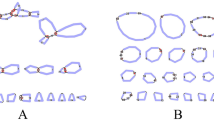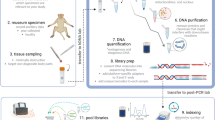Abstract
Genus Pseudagrion is one of the largest genera of order Odonata and 14 species of this genus have been reported in India. The current research aims to reconstruct the phylogenetic trees by amplifying the partial sequences of the following three mitochondrial genes: COI, ND1 and 16 S rRNA genes, to produce a DNA reference library and determine the evolutionary relationships among the species of genus Pseudagrion. Sequences of mitochondrial genes of eight species have been submitted to NCBI, out of which Pseudagrion decorum, P. hypermelas and P. indicum barcoded for the first time. Since no work has been reported to far for CUB in genus Pseudagrion, the MT-ND1 gene appears to be a good choice for analyzing codon usage pattern. Codon usage bias for mitochondrial genes is low because of high effective number of codons. The most frequent codons, favored A or T at the 3rd codon position which indicate the significant role of compositional constraint in codon usage bias. Genetic divergence based on COI and 16 S rRNA ranges from 2.4 to 15.8%. 12 S rRNA and 16 S rRNA genes show minor genetic diversity, whereas NDI and COI genes reveal higher genetic diversity because of high mutation rate. In phylogenetic tree, 34 Pseudagrion species get segregated into five major clades as: ((P. pruinosum + P. spencei + P. hypermelas + P. rubriceps) + P. microcephalum) + (P. decorum + P. indicum + P. australasiae) + ((P. aureolum) + P. massaicum + P. tanganyicum + P. hamoni + P. pacale + P. niloticum + P. acacia) + (P. ignifer + P. pilidorsum + P. pruinosum) + ((P. dactylidium) + P. bicoerulans + P. munte + P. sarepi + P. kersteni) that depicts their evolutionary relationships.


















Similar content being viewed by others
References
Akashi H (1997) Codon bias evolution in Drosophila. Population genetics of mutation-selection drift. Gene 205(1–2):269–278
Beatty CD, Sánchez Herrera M, Skevington JH, Rashed A, Van Gossum H, Kelso S, Sherratt TN (2017) Biogeography and systematics of endemic island damselflies: the Nesobasis and Melanesobasis (Odonata: Zygoptera) of Fiji. Ecol Evol 7(17):7117–7129
Bergmann T, Rach J, Damm S, Dasalle R, Schierwater B, Hadrys H (2013) The potential of distance-based thresholds and character-based DNA barcoding for defining problematic taxonomic entities by COI and ND. Mol Ecol Resour 13(6):1069–1081
Bybee SM, Ogden TH, Branham MA, Whiting MF (2008) Molecules, morphology and fossils: a comprehensive approach to odonate phylogeny and the evolution of the odonate wing. Cladistics 24(4):477–514
Carchini G, Solimini AG, Ruggiero A (2005) Habitat characteristics and odonate diversity in mountain ponds of central Italy. Aquat Conserv Mar Freshw Ecosyst 15:573–581
Crozier RH, Crozier YC (1993) The mitochondrial genome of the honeybee Apis mellifera: complete sequence and genome organisation. Genetics 133:97–117
De Mandal S, Chhakchhuak L, Gurusubramanian G, Kumar NS (2014) Mitochondrial markers for identification and phylogenetic studies in insects–A review. DNA Barcodes 2(1):1–9. https://doi.org/10.2478/dna-2014-0001
Dijkstra KDB, Groenevel LF, Clausnitzer V, Hadrys H (2007) The Pseudagrion split: molecular phylogeny confirms the morphological and ecological dichotomy of Africa’s most diverse genus of Odonata (Coenagrionidae). Int J Odonatol 10(1):31–41
Dijkstra KDB, Kalkman VJ, Dow RA, Stokvis FR, Tol JV (2014) Redefining the damselfly families: a comprehensive molecular phylogeny of Zygoptera (Odonata). Syst Entomol 39(1):68–96
Dijkstra KDB, Kipping J, Mézière N (2015) Sixty new dragonfly and damselfly species from Africa (Odonata). Odonatologica 44(4):447–678
Folmer O, Black M, Hoeh W, Lutz R, Vrijenhoek R (1994) DNA primers for amplification of mitochondrial cytochrome c oxidase subunit I from diverse metazoan invertebrates. Mol Mar Biol Biotechnol 3(5):294–299
Fraser FC (1933) The Fauna of British India, Odonata. I. Taylor and Francis, London, pp 1–419
Fu YX (1997) Statistical tests of neutrality of mutations against population growth, hitchhiking and background selection. Genetics 147(2):915–925
Futahashi R (2011) A revisional study of Japanese dragonflies based on DNA analysis. Tombo 53:67–74
Godfray HCJ (2002) Challenges for taxonomy-the discipline will have to reinvent itself if it is to survive and flourish. Nature 417:17–19. https://doi.org/10.1038/417017a
Golfieri B, Hardersen S, Maiolini B, Surian N (2016) Odonates as indicators of the ecological integrity of the river corridor: development and application of the Odonate River Index (ORI) in northern Italy. Ecol Ind 61:234–247
Gun L, Yumiao R, Haixian P, Liang Z (2018) Comprehensive Analysis and comparison on the Codon usage pattern of whole Mycobacterium tuberculosis Coding Genome from different area. Biomed Res Int 8:3574976
Hebert PDN, Ratnasingham S, deWaard JR (2003) Barcoding animal life: Cytochrome C Oxidase Subunit 1 divergences among closely related species. The Proceeding of Royal Society, London B: Biological Sciences 270:96–99
Huang M, Zhong Y, Ma X, Hu Q, Fu M, Han Y (2019) Analysis of codon usage in the mitochondrion genome of Spirodela polyrhiza. Aquat Bot 156:65–72
Ikemura T (1985) Codon usage and tRNA content in unicellular and multicellular organisms. Mol Biol Evol 2(1):13–34
Islam SU, Arif M, Lin W, Islam W, Qasim M, Ali H, Ali H, Khan KA, Ghramh HA, Du Z, Wu Z (2020) Molecular identification of seven new Zygopteran genera from South China through partial cytochrome oxidase subunit I (COI) gene. Meta Gene 25:100739
Jordan S, Simon C, Polhemus D (2003) Molecular systematic and adaptive radiation of Hawaii’s endemic damselfly genus Megalagrion (Odonata: Coenagrionidae). Syst Biol 52(1):89–109
Kambhampati S, Rai KS (1991) Mitochondria1 DNA variation within and among populations of the mosquito aedes albopictus. Genome 34:288–292
Katewa SD, Ballard JWO (2007) Sympatric Drosophila simulans flies with distinct mtDNA show difference in mitochondrial respiration and electron transport. Insect Biochem Mol Biol 37:213–222
Kimura M (1980) A simple method for estimating evolutionary rate of base substitutions through comparative studies of nucleotide sequences. J Mol Evol 16(2):111–120
Kvist J, Mattila AL, Somervuo P, Ahola V, Koskinen P, Paulin L, Salmela L, Fountain T, Rastas P, Ruokolainen A, Taipale M (2015) Flight-induced changes in gene expression in the Glanville Fritillary butterfly. Mol Ecol 24(19):4886–4900
Lessinger AC, Martins Junqueira AC, Lemos TA, Kemper EL, da Silva FR, Ettore AL, Arrunda P, Azeredo-Espin AML (2000) The mitochondrial genome of the primary screwworm fly Cochliomyia hominivorax (Diptera: Calliphoridae). Insect Mol Biol 9:521–529. https://doi.org/10.1046/j.1365-2583.2000
Librado P, Rozas J (2009) DnaSP v5: a software for comprehensive analysis of DNA polymorphism data. Bioinformatics 25:1451–1452
National Center for Biotechnology Information (NCBI) (1988) [Internet] Bethesda (MD): National Library of Medicine (US), National Center for Biotechnology Information. https://www.ncbi.nlm.nih.gov/
Newell C, Kane CL, Kane DA (2016) Mitochondrial substrate specificity in beetle flight muscle: assessing respiratory oxygen flux in small samples from Dermestes maculatus and Tenebrio molitor. Physiol Entomol 41:96–102
Ning X, Kompier T, Yu X, Bu W (2016) Paracercion ambiguum sp. nov. from Lang Son, Vietnam (Zygoptera: Coenagrionidae). Zootaxa 4144(2):263–275
Paulson D, Schorr M, Abbott J, Bota-Sierra C, Deliry C, Dijkstra KD, Lozano F (2022) The World Odonata List. Catalogue of Life Checklist. https://doi.org/10.48580/dfqz-75rv
Peel MC, Finlayson BL, McMahon TA (2007) Updated world map of the Köppen–Geiger climate classification Hydrol. Earth Syst Sci 11(5):1633–1644. https://doi.org/10.5194/hess-11-1633-2007
Pramual P, Thanee I, Uttaruk Y, Thaijarern J, Wongpakam K (2020) Efficiency of DNA barcodes for identification and documenting aquatic insect diversity in Rice Fields. Trop Nat History 20(2):169–181
Rach J, Bergmann T, Paknia O, DeSalle R, Schierwater B, Hadrys H (2017) The marker choice: unexpected resolving power of an unexplored CO1 region for layered DNA barcoding approaches. PLoS ONE 12(4):e0174842
Rach J, DeSalle R, Sarkar I, Schierwater B, Hadrys H (2008) Character-based DNA barcoding allows discrimination of genera, species and populations in Odonata. Proceedings of the Royal Society B: Biological Sciences 275(1632):237–247. https://doi.org/10.1098/rspb.2007.1290
Ratnasingham S, Hebert PDN (2007) BOLD: the Barcode of Life Data System. Mol Ecol Notes 7:355–364
Sahney S, Benton MJ, Falcon-Lang HJ (2010) Rainforest collapse triggered Pennsylvanian tetrapod diversification in Eurameric. Geology 38:1079–1082
Salin K, Auer SK, Rey B, Selman C, Metcalfe NB (2015) Variation in the link between oxygen consumption and ATP production, and its relevance for animal performance. Proc Royal Soc B: Biol Sci 282(1812):1028
Samways MJ (2008) Dragonflies and damselflies of South Africa, 1st ed. Sofia, Pensof. ISBN 978-954-642-330-6
Sanchez-Guillen RA, Wellenreuther M, Cordero-Rivera A, Hansson B (2011) Introgression and rapid species turnover in sympatric damselflies. BMC Evol Biol 11(1):1–17
Sandamini PMMA, Gunarathna SD, Chandana EPS (2019) Habitat quality and climate variability determine odonate species diversity and distribution patterns in selected habitats of southern Sri Lanka. Asian J Conserv Biology 8:47–57
Sharp PM, Li WH (1986) An evolutionary perspective on synonymous codon usage in unicellular organisms. J Mol Evol 24:28–38
Sharp AH, McPherson PS, Dawson TM, Aoki C, Campbell KP, Snyder SH (1993a) Differential immune histochemical localization of inositol 1, 4, 5-trisphosphate-and ryanodine-sensitive Ca2 + release channels in rat brain. J Neurosci 13(7):3051–3063
Sharp PM, Stenico M, Peden JF, Lloyd AT (1993b) Codon usage: mutational bias, translational selection, or both? Biochem Soc Trans 21(4):835–841
Stork NE (2018) How many species of insects and other terrestrial arthropods are there on Earth? Ann Rev Entomol 63:31–45
Subramanian KA (2009) Dragonflies of India-A field guide. Govt. Vigyan Prasar, Department of Science and Technology, of India, pp 1–168
Subramanian KA, Babu R (2017) A checklist of Odonata (Insecta) of India. Version 3.0. https://zsi.gov.in/WriteReadData/userfiles/file/Checklist/Odonata%20V3.pdf
Tajima F (1989) Statistical method for testing the neutral mutation hypothesis by DNA polymorphism. Genetics 123(3):585–595
Tallei TE, Koneri R, Kolondam BJ (2017) Sequence analysis of the cytochrome C oxidase subunit I gene of Pseudagrion pilidorsum (Odonata: Coenagrionidae). Makara J Sci 30:43–52
Tamura K, Stecher G, Kumar S (2021) MEGA11: molecular evolutionary genetics analysis version 11. Mol Biol Evol 38(7):3022–3027
Wigglesworth VB (1976) Insects and the life of Man. Collected essays in pure science and Applied Biology. Chapman and Hall, London, p 217
Yeo D, Puniamoorthy J, Ngiam RW, Meier R (2018) Towards holomorphology in entomology: rapid and cost-effective adult–larva matching using NGS barcodes. Syst Entomol 43(4):678–691
Funding
Financial support was given to Dr. Gagandeep Kaur Dhillon (SRF) by Council of Scientific and Industrial Research (CSIR), NEW DELHI, India for Project entitled “DNA Barcoding of Dragonflies and Damselflies (Odonata: Insecta) based on Mitochondrial COI Gene” under the Dr. Gurinder Kaur Walia (Principal Investigator), Department of Zoology and Environmental Sciences, Punjabi University, Patiala [37(1716)/18/EMR-II].
Author information
Authors and Affiliations
Corresponding author
Ethics declarations
We declare that we have not sent the paper, same as this manuscript for publication anywhere else. We also declare that we have faithfully acknowledged, given credit to and referred to the research workers wherever their works have been cited in the text and the body of the thesis. We further certify that we have not willfully lifted up some other’s work, para, text, data, results, etc. reported in the journals, books, magazines, reports, dissertations, theses, etc., or available at web-sites and included them in this research paper and cited as our own work. We also declare that we have adhered to all the rules of International Journal of Tropical Insect Science in our submission.
Ethics
There is no need of ethical permission for this research.
Conflict of interest
We certify that we have no conflict of interest.
Additional information
Publisher’s Note
Springer Nature remains neutral with regard to jurisdictional claims in published maps and institutional affiliations.
Rights and permissions
Springer Nature or its licensor (e.g. a society or other partner) holds exclusive rights to this article under a publishing agreement with the author(s) or other rightsholder(s); author self-archiving of the accepted manuscript version of this article is solely governed by the terms of such publishing agreement and applicable law.
About this article
Cite this article
Walia, G.K., Dhillon, G.K. DNA barcoding and molecular phylogeny of genus Pseudagrion (Odonata: Coenagrionidae) based on mitochondrial COI, ND1 and 16S rRNA genes. Int J Trop Insect Sci (2024). https://doi.org/10.1007/s42690-024-01256-y
Received:
Accepted:
Published:
DOI: https://doi.org/10.1007/s42690-024-01256-y




